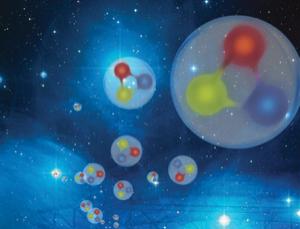NewScientist.com | Stephen Battersby | Nov. 20, 2008

Matter is built on flaky foundations. Physicists have now confirmed that the apparently substantial stuff is actually no more than fluctuations in the quantum vacuum.
The researchers simulated the frantic activity that goes on inside protons and neutrons. These particles provide almost all the mass of ordinary matter.
Each proton (or neutron) is made of three quarks – but the individual masses of these quarks only add up to about 1% of the proton’s mass. So what accounts for the rest of it?
Theory says it is created by the force that binds quarks together, called the strong nuclear force. In quantum terms, the strong force is carried by a field of virtual particles called gluons, randomly popping into existence and disappearing again. The energy of these vacuum fluctuations has to be included in the total mass of the proton and neutron.
But it has taken decades to work out the actual numbers. The strong force is described by the equations of quantum chromodynamics, or QCD, which are too difficult to solve in most cases.
So physicists have developed a method called lattice QCD, which models smooth space and time as a grid of separate points. This pixellated approach allows the complexities of the strong force to be simulated approximately by computer.
Gnarly calculation
Until recently, lattice QCD calculations concentrated on the virtual gluons, and ignored another important component of the vacuum: pairs of virtual quarks and antiquarks.
Quark-antiquark pairs can pop up and momentarily transform a proton into a different, more exotic particle. In fact, the true proton is the sum of all these possibilities going on at once.
Virtual quarks make the calculations much more complicated, involving a matrix of more than 10,000 trillion numbers, says team member Stephan Dürr of the John von Neumann Institute for Computing in Jülich, Germany.
“There is no computer on Earth that could possibly store such a big matrix in its memory,” Dürr told New Scientist, “so some trickery goes into evaluating it.”
Crunch time
Several groups have been working out ways to handle these technical problems, and five years ago a team led by Christine Davies of the University of Glasgow, UK, managed to calculate the mass of an exotic particle called the B_c meson.
That particle contains only two quarks, making it simpler to simulate than the three-quark proton. To tackle protons and neutrons, Dürr’s team used months of time on the parallel computer network at Jülich, which can handle 200 teraflops – or 200 trillion arithmetical calculations per second.
Even so, they had to tailor their code to use the network efficiently. “We spent an enormous effort to make sure our code would make optimum use of the machine,” says Dürr.
Without the quarks, earlier simulations got the proton mass wrong by about 10%. With them, Dürr gets a figure within 2% of the value measured by experiments.
Higgs field
Although physicists expected theory to match experiment eventually, it is an important landmark. “The great thing is it shows that you can get close to experiments,” says Davies. “Now we know that lattice QCD works, we want to make accurate calculations of particle properties, not just mass.”
That will allow physicists to test QCD, and look for effects beyond known physics. For now, Dürr’s calculation shows that QCD describes quark-based particles accurately, and tells us that most of our mass comes from virtual quarks and gluons fizzing away in the quantum vacuum.
The Higgs field is also thought to make a small contribution, giving mass to individual quarks as well as to electrons and some other particles. The Higgs field creates mass out of the quantum vacuum too, in the form of virtual Higgs bosons. So if the LHC confirms that the Higgs exists, it will mean all reality is virtual.
HT: NewScientist




Matter is really 99% highly-controlled and super-organized energy. Light (energy) and Logos form the basis of EVERYTHING. More proof that GOD’s truth and reality permeates every molecule of His creation. So much for the lunacy and idiocy of Darwinism and atheism.
I’ve always been intrigued by the Trinitarian formations and the incredible dynacism that exists where we see only solid. Seems to me to be a perfect proof of St. Maximus, the Confessor. The logoi.
Psalm 18[19]:1,3 — “The heavens declare the glory of God, and the firmament proclaimeth the work of His hands. There are no tongues nor words in which their voices are not heard.”
Are you saying that the existence of the laws of physics serves as proof of God’s truth?
Some might say that God is the laws of physics, while others posit that He is capable of violating them.
Yes Phil, the existence of universal laws that control all matter, even at the smallest sub-atomic level prove beyond a shadow of a doubt that Reason (GOD) created and sustains the entire Universe. The alternative explanation of “chance” and “chaos” creating and sustaining anything is really, really, bad fiction, a delusional myth that even a small child would dismiss as preposterous.
The existence of laws of physics that are constant throughout the known universe serve as proof of the existence of God?
So, the only way to disprove the existence of God would be to provide an example of something that occurs contrary to the laws of physics.
So, a miracle that defies the laws of physics would simultaneously prove and disprove the existence of God?
We all seem to agree (you, me, and the authors of this article) that matter and energy, and/or vacuum fluctuations, follow the laws of physics. Who are the people who present the explanation that the laws of physics don’t exist, and that instead “chance” and “chaos” create and sustain things?